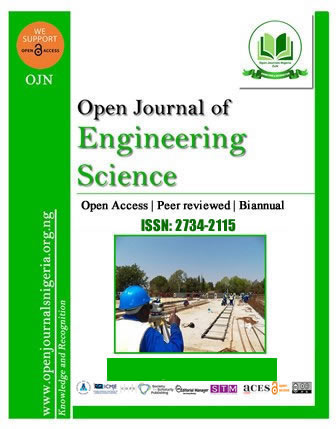IMPACT OF THE DISPOSAL AND UTILIZATION OF WUPA WASTEWATER TREATMENT PLANT SLUDGE ON THE ENVIRONMENT
DOI:
https://doi.org/10.52417/ojes.v3i2.454Keywords:
Sewage Sludge, Environmental impact, Groundwater quality, Disposal RouteAbstract
The complete management of waste arising from various human activities due to increasing urbanization and industrialization puts the environment in danger of pollution, as it translates to waste generation that must be treated and disposed of. Wupa Wastewater Treatment Plant with a design capacity of 131,000 m3/day (dry weather inflow) was conceived to treat the domestic wastewater generated from the Federal Capital City of Abuja. The effects of sludge disposal and reuse on the environment were determined. Questionnaires were physically self-administered in printed copies to the staff of the Wupa treatment plant, Aviation farm staff, and residents of the Wupa community, sludge samples were taken from the disposal bed, and water samples were taken from the River and Dug wells closest to the disposal bed, and places of reuse for physiochemical analysis in a laboratory. The chemical parameters of the samples were statistically analysed and the results showed that turbidity presented a mean value of 8.60NTU, as well as a significate concentration of Nitrate 8.23mg/l, and cadmium (0.05mg/l). Test of variance shows a significant difference in the values of sulphate and Nitrate (0.028 and 0.03 respectively) compared with the World Health Organization guidelines for natural surface and groundwater. Findings showed that of the 547.2 tons of the sludge produced annually 90.28% is disposed at the plants’ sludge bed, 9% is used for agriculture, and 0.8% is used by research institutions, meaning utilization is very minimal. Land applications and disposal are environmentally safe as chemical parameters are significantly below the FEPA guidelines, but there is a higher concentration of Nitrate that makes the sludge unsafe to discharge to water bodies or heavily applied to lands with high water Tables as it can cause nutrients leachate. Finally, the overall impact evaluation of disposal and utilization of the sludge has only about 12% negative impact in the immediate environment of disposal and use
Published
How to Cite
Issue
Section
Copyright (c) 2023 Francis & Ndububa

This work is licensed under a Creative Commons Attribution 4.0 International License.



















